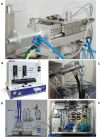A digital twin for 64Cu production with cyclotron and solid target system
- PMID: 36371472
- PMCID: PMC9653460
- DOI: 10.1038/s41598-022-23048-5
A digital twin for 64Cu production with cyclotron and solid target system
Abstract
One method for finding reliable and cost-effective solutions for designing radioisotope production systems is represented by the "digital twin" philosophy of design. Looking at cyclotron solid targets, uncertainties of the particle beam, material composition and geometry play a crucial role in determining the results. The difference between what has been designed and what can be effectively manufactured, where processes such as electroplating are poorly controllable and generate large non-uniformities in deposition, must also be considered. A digital twin, where the target geometry is 3D scanned from real models, can represent a good compromise for connecting "ideal" and "real" worlds. Looking at the 64Ni(p,n)64Cu reaction, different Unstructured-Mesh MCNP6 models have been built starting from the 3D solid target system designed and put into operation by COMECER. A characterization has been performed considering the designed ideal target and a 3D scan of a real manufactured target measured with a ZEISS contact probe. Libraries and physics models have been also tested due to limited cross-section data. Proton spectra in the target volume, 3D proton-neutron-photon flux maps, average energies, power to be dissipated, shut-down dose-rate, 64Cu yield compared with various sources of experimental data and beam axial shifting impact, have been estimated. A digital twin of the 64Ni(p,n)64Cu production device has been characterized, considering the real measured target geometry, paving the way for a fully integrated model suitable also for thermal, structural or fluid-dynamic analyses.
© 2022. The Author(s).
Conflict of interest statement
The authors declare no competing interests.
Figures








References
-
- Ruth TJ. The shortage of technetium-99m and possible solutions. Annu. Rev. Nucl. Part. Sci. 2020;70(1):77–94. doi: 10.1146/annurev-nucl-032020-021829. - DOI
-
- Papash AI, Alenitsky YG. Commercial cyclotrons. Part I: Commercial cyclotrons in the energy range 10–30 MeV for isotope production. Phys. Part. Nucl. 2008;39:597–631. doi: 10.1134/S1063779608040060. - DOI
-
- Jones D, Snider C, Nassehi A, Yon J, Hicks B. Characterizing the digital twin: A systematic literature review. CIRP J. Manuf. Sci. Technol. 2020;29:36–52. doi: 10.1016/j.cirpj.2020.02.002. - DOI
Grants and funding
- The UNIBO research group (L. I., M. S.) has been funded by Comecer S.p.A in the framework of a research contract on solid targets modelling./Comecer (Italy), Italy
- The UNIBO research group (L. I., M. S.) has been funded by Comecer S.p.A in the framework of a research contract on solid targets modelling./Comecer (Italy), Italy
LinkOut - more resources
Full Text Sources

